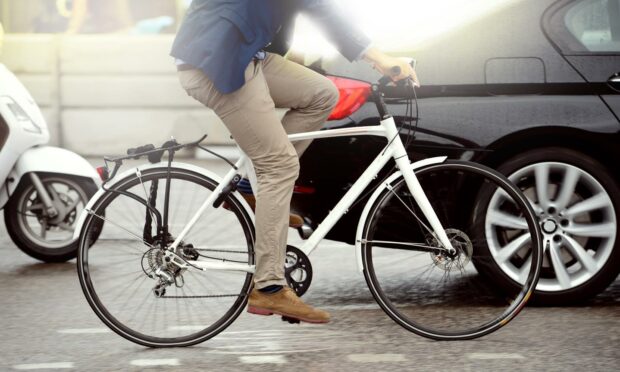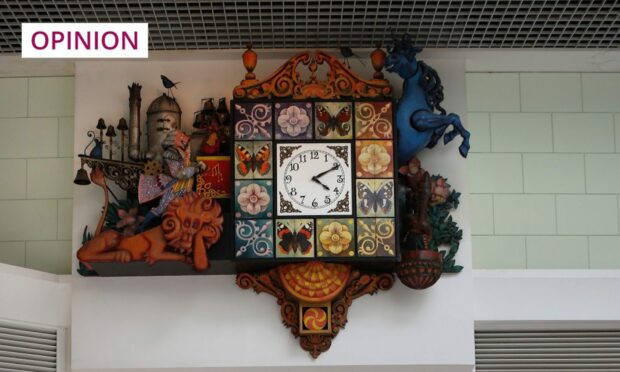Sir, – If Courier readers followed the advice of your columnist Alistair Heather about opening their car doors by winding down the window, and trying to open the door with the outside handle they will probably injure themselves with the near-impossible contortion.
No, it’s much easier than that.
The new Highway Code states, at rule 239, “where you are able to do so, you should open the door using your hand on the opposite side to the door you are opening; for example, use your left hand to open a door on your right-hand side. This will make you turn your head to look over your shoulder.”
He also doesn’t seem to think that the Highway Code is worth it.
Until we have fewer cars on the roads and more people are encouraged to cycle on proper cycle lanes (rather than the cheap and dangerous solution of bumps in the road as in Perth Road, Dundee), it’s the best we’ve got, and I welcome it.
I should declare an interest – I am a cyclist.
Donald Gordon. St Bride’s Cottage, South Kingennie.
Question of integrity over independence prospectus
Sir, – The civil servants charged with writing the independence prospectus will have to choose between maintaining their integrity and disappointing their SNP masters.
No civil servant could have committed to paper the lie, uttered by SNP Westminster leader Ian Blackford and Finance Secretary Kate Forbes, then defended by First Minister Nicola Sturgeon in the Scottish Parliament, that the UK would pay for Scottish pensions after independence.
It is a liberty that only politicians could take but it fits well in a series of lies that includes the following:
1. Scotland is a net contributor to UK tax revenues;
2. Scottish products, like whisky, exported through English ports, are recorded as English exports;
3. The annual GERS reports, which reveal giant holes in our balance sheet, are “Tory” statistics;
4. Scotland can leave the UK without paying a share of UK national debt.
Usually, such whoppers are concocted at lower levels in the party and circulate on social media where they are eagerly taken up by supporters who repeat them parrot-fashion.
Plausibility is more important than veracity. The purpose is to give the independence project a rigour which the facts do not support.
If the civil servants can produce a document which sticks to facts but satisfies their brief they will have earned the £711,000 salary costs many times over.
Denis Munro. St John’s Place, Perth.
‘Project fear’ has no place in MPs’ debate
Sir, – I read without surprise the trio of letters from the Tory tendency in The Courier of February 4. All authors of these letters had a common theme, that they hate the idea of Scottish freedom.
All were based on the same negative (even ignorant) view of Scotland and naturally all contained an amount of vitriol towards nationalist politicians.
Of course, those in favour of the union have a good case to make, a positive case.
But the problem is that instead of making the positive case, some seem intent to rerun “project fear”, running down Scotland and making out that removing our collective necks from beneath the Tory jackboot will leave us like a starving Third World nation.
Even David Cameron admitted that Scotland, like Denmark, Norway and Finland, for example, could be a perfectly viable Northern European country and, of course, we can do just fine.
A free Scotland would not be led by the hypocrisy that sets rules and even laws for us, the plebs who pay tax, and no rules at all for our Tory lords and masters who spend it on their Old Etonian chums.
Karen Heath. Cortachy, Kirriemuir.
SNP backing of EU not always the case
Sir, – I refer to your correspondent Iain MacEchern (Scotland would be free to thrive within EU, Courier, February 5).
May I ask Mr MacEchern to enlighten me as to the source of the current SNP leadership’s enthusiasm with the EU? I ask from a genuinely apolitical interest, having postulated this question to several nationalist-supporting colleagues and acquaintances over a period of time without receiving a satisfactory answer.
From the inception of the then EEC, the nationalist movement mistrusted and abhorred the institution. Indeed, in the 1975 referendum, the SNP were the only party to vote against the UK’s proposal to join.
Winnie Ewing stated that membership would be tantamount to a death warrant for Scotland, and would destroy its long-term prosperity.
Indeed, Donald Stewart, leader of the parliamentary group, went further, saying “the EEC represents everything that the nationalist movement has fought against – centralisation, undemocratic procedures, power politics, and a fetish for abolishing cultural differences”.
The SNP’s position appeared to do a 180 degree turn around 2008, to embrace a complete espousal of all things Brussels- led, lacking any explanation for this road to Damascus conversion.
At the risk of seeming disingenuous, the only correlation I can find is that it coincided with the UK’s growing mistrust of the EU. I stand willing to be enlightened.
Jim Millar. Stenhouse Street, Cowdenbeath.
Level up by removing the Lords and royalty
Sir, – If the government is serious about levelling up the vast divisions in society, they should start with getting rid of the unelected House of Lords which contains 850 people getting £48,000 per annum, plus expenses, then start on the outdated monarchial system, the expense of which can only be guessed at, but it will be phenomenal as there are a lot of them.
On the other side we have people queuing up at foodbanks to keep themselves alive, and having to choose between turning on their heating or feeding their children.
The Gove attempt to divert attention away from partygate has fallen on deaf ears.
Alister Rankin. Whyterose Terrace, Methil.
Dutch Reach places obligation on all drivers and passengers to look first
Sir, – Alistair Heather’s opinion piece may have had greater worth if it had been factually correct.
The Dutch Reach which is now advised within the Highway Code is part of a new section under rule 239 and has been in force from January 29.
It places an obligation on all drivers and passengers, where they are able, to open their car door with their arm and hand furthest from the door – so that’s the right arm for a passenger and a left arm for the driver.
This ensures that when a car door is opened by the occupant the body and shoulder and head turns, allowing an easy glance over the shoulder to prevent “dooring” pedestrians, cyclists or other vulnerable road users.
There is no need to open the window and then open the car door from the inside using the outside handle – both not required and physically impossible.
Surely using the Dutch Reach is not a lot to ask when it protects our children?
More than 500 people every year are injured in dooring accidents – some people also lose their lives.
Mr Heather’s advice to throw away the Highway Code may not only cause injury to others but also result in a £1,000 fine where injury occurs.
Moreover, under section 42 of the Road Traffic Act, dooring a cyclist is a criminal offence.
Please don’t ask me why Chris Grayling in 2016, then acting-UK Government transport minister, was not subject to criminal proceedings when he doored a cyclist in Whitehall when getting out of a ministerial car – perhaps he was on his way to a party at Downing Street?
Mr T G Lamb. Bamff View, New Alyth.
Door chop logic is difficult to grasp
Sir, – I know that we are all trying to keep classrooms in schools as healthy as possible for our young students but cutting the bottoms off several thousand classroom doors, as suggested by Nicola Sturgeon, sounds like sheer lunacy to me.
Why destroy those doors to get ventilation when leaving them and a window or two slightly ajar would achieve the same air-flow through the room?
Is there something I’m not seeing here?
Archibald A Lawrie. Church Wynd, Kingskettle.
Double standards over school doors
Sir, – I was gobsmacked watching the squabble between First Minister Nicola Sturgeon and the leader of the Scottish Conservative Party, Douglas Ross, about the FM having a brilliant idea and proposing to cut the bottom off fire safety doors in schools to improve ventilation in classrooms.
When, rightly so, Douglas Ross pointed to the fact that this is totally against the safety rules from the fire services, it was said he was nitpicking.
We are forced by the first minister and her government to fork out hundreds of pounds for interlinked alarms to improve the fire-safety standards at home and prevent deaths, yet the very same FM and her government find it OK to totally compromise the fire safety in schools by chopping safety doors, exposing the children and teachers to grave danger.
The doors in classrooms are developed this way to prevent fire and smoke spreading rapidly from classroom to classroom.
This is what I call leading with double standards!
At home we have to abide to safety standards at all costs, but in school buildings – where hundreds if not thousands of people are – safety is not important and can be compromised.
The FM has the brass neck to call chopping doors at school common sense.
Where is the logic here?
Maaike Cook. Cash Feus, Strathmiglo.
Shortening plan needs reality check
Sir, – Heavens above, what will they come up with next?
In the same week we Scots are being forced to install fire alarms at our own cost, our education secretary is suggesting the doors in classrooms should be shortened.
I would like to hear what the fire service has to say about that one…
It’s usually along the lines of, in the event of a fire, remember to close all doors.
I fear her boss told her to go and stand in the dunce’s corner and earn her dolly mixtures.
What’s next on the twaddle list.
A bonus of jelly babies?
Mrs S Walker. Letham, Perth.
Apply for one-off energy discount
Sir, – To ensure that householders who qualify for the 25% occupancy discount benefit from 100% of the forthcoming £150 energy discount payable in April, this discount must be applied after the amount due by the householder is calculated, and not applied to the gross charge.
The difference, if applied incorrectly, may be small, but as the one-off discount of £150 is publicly funded, local authorities would not be entitled to deny the full amount due to the householder.
In every case where the householder is eligible for this discount, the full amount must be applied.
Shelagh Gardiner. Westgate, Friockheim.









